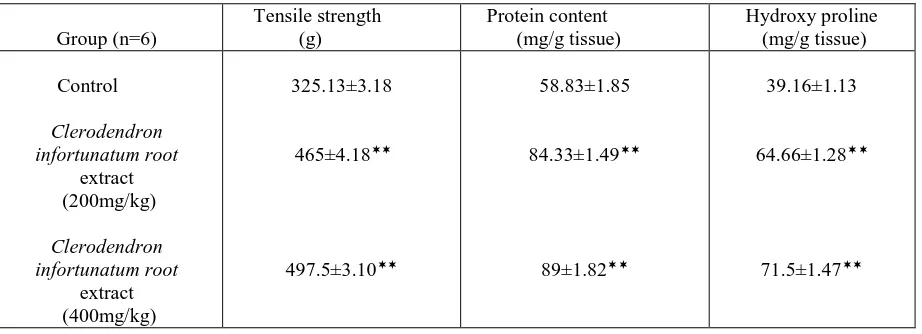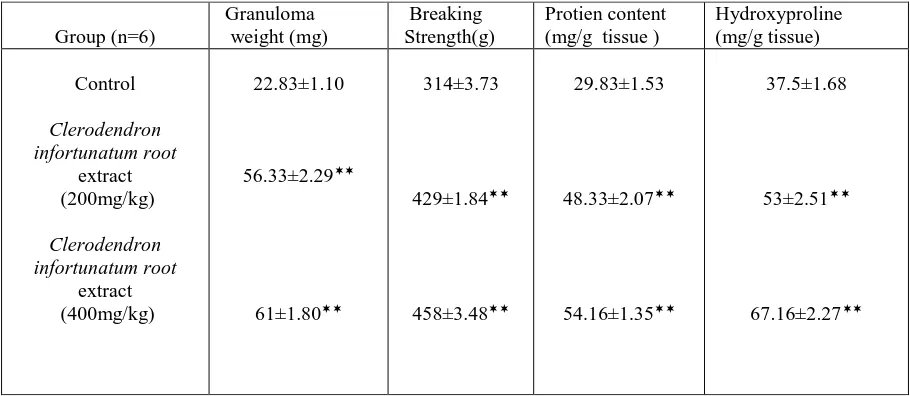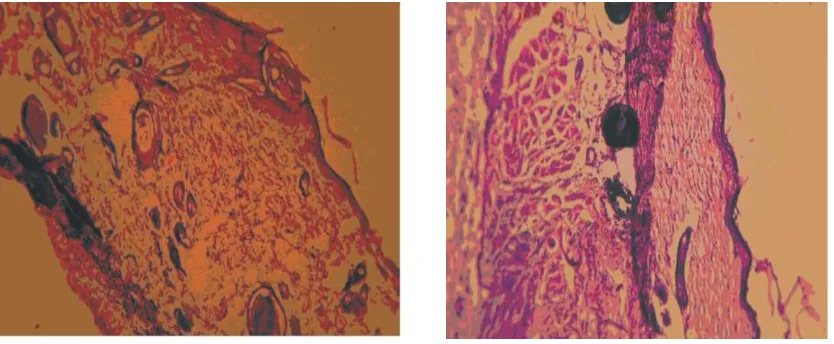w w w . i a j p s . c o m
Page 814
CODEN (USA): IAJPBB ISSN: 2349-7750
I
IN
ND
DO
O
A
AM
ME
ER
RI
IC
CA
AN
N
J
JO
OU
UR
RN
NA
AL
L
O
OF
F
P
P
H
H
A
A
R
R
M
M
A
A
C
C
E
E
U
U
T
T
I
I
C
C
A
A
L
L
S
S
C
C
I
I
E
E
N
N
C
C
E
E
S
S
Available online at:
http://www.iajps.com
Research Article
ISOLATION, SPECTRAL IDENTIFICATION OF
QUERCETIN, AND DETERMINATION OF WOUND
HEALING ACTIVITY FROM THE ALCOHOLIC ROOT
EXTRACT OF CLERODENDRON INFORTUNATUM LINN
Leena.P.N
1*, Dr. Sundaraganapathy
21
Research Scholor of Karpagam University, Coimbatore, Tamilnadu, India.
2DEAN of Karpagam University, Coimbatore,Tamilnadu,India.
Abstract:
Plant materials are used throughout developed and developing countries as home remedies, over the counter drug products and raw materials for the pharmaceutical industry and represent a substantial proportion of the global drug market. It is therefore essential to establish internationally recognized guidelines for assessing their quality. Some of quality control parameters of the root Clerodendron species belonging to Verbenceae family were analyzed. It includes root powder characters, moisture content determination by LOD method, FOM determination, Rf value detection by TLC, using different solvents, Ashvalues, extractive values, bitterness value, Haemolytic activity, detection of tannins, Foaming Index, Detection of Arsenic and heavy metals, determination of micro organism. The isolation of the compound from the extract by coloumn chromatography by using different solvents ,purified ,analysed by various spectral studies . The study ensures that the quality control parameters do help in the proper standard of the crude drugs in drug development process for global acceptances. The current study may be useful to progress further investigation on the isolation of other flavanoids and their biological potential for the treatment of human ailments.
Keywords: C. infortunatum,UV, IR ,NMR, MASS spectroscopy.
Corresponding author:
Leena. P. N,
Research Scholor of Karpagam University,
Coimbatore,Tamilnadu, India.
E mail:leena09narayanan@gmail.com
Please cite this article in press as Leena.P.N and Dr. Sundaraganapathy, Isolation, Spectral Identification of Quercetin, and Determination of Wound Healing Activity from the Alcoholic Root Extract of Clerodendron
Infortunatum Linn, Indo Am. J. P. Sci, 2016; 3(8).
w w w . i a j p s . c o m
Page 815
INTRODUCTION:
Clerodendron infortunatum Linn, (Family :Verbenaceae ) ¹ is a species found in India, It is reported as folk remedy for tumours , leprosy , fever , infection , inflammation .The roots have been reported to possess laxative ,diuretic ,analgesic ,anti inflammatory, anti tumour and antibacterial activities¹. In the present study the root portions of Clerodendron paniculatum Linn comprising, phytochemical and spectral analysis..The root was extracted with ethanol, extraction. The vaccum dried extracts were screened various phytoconstituent and TLC, HPTLC, spectral analysis analysis. The flavanoids of plant origin are versatile in biological activities. Their presence in plants may be due to one of the purpose such as defence such as microbial attack as precursor or as metabolic end product of plant metabolism .Isolation of flavanoids by solvent extraction supposed to be a very tedious process because of its magnitude of reactivity with other molecule of plants.
MATERIALS AND METODS:
Experimental Section
The plant C.paniculatum was collected from Pathanamthitta district of Kerala and identified by Thomas Mathew, HOD of Botany, Marthoma College Tiruvalla, Kerala .Voucher no. VSCI-15 was deposited in the Pharmacognosy department, Pushpagiri College of pharmacy, Tiruvalla.
Preparation of Extract
The root portion of the plant was washed with running water to remove soil and other matter and dried in shade for 20 days, powdered, extracted 500gm with ethanol (EECi) by cold extraction to yield the extract. The extract were reduced to molten mass by rotary vaccum evaporator and the yield was 21% w/w
Phytochemical Screening
The root portion of the plant was washed with running water to remove soil and other matter and dried in shade for 20 days, powdered, extracted 500gm with ethanol by cold extraction to yield the extract. The extract were reduced to molten mass by rotary vaccum evaporator and the yield was 25%w/w.Preliminary phytochemical screening was performed as per standard procedure and various phytochemical constituents were identified6,7 such
as carbohydrates, starch, mucilage ,saponins ,flavanoids ,tannins ,phenolic compounds in the different extract .
Isolation and characterisation of active constituents
Alcoholic extract of Clerodendron infortunatum Linn was successively partitioned with hexane ,dichloromethane ,ethyl acetate ,and butanol .The
combined organic layer of each fractions was evaporated to dryness to get molten mass.The ethyl acetate fraction 6.8gm was fractionated on silica gel coloumn chromatography using subjected to coloumn chromatography using CHCL3 up to 100% followed by increasing
gradient of MeOH up to 100% .The isolate were collected in 50 ml portions and monitored on TLC using solvent Dichloromethane MeOH(7.5:2.5).The fractions that showed similar Rf were mixed and
concentrated .The isolate named as CiA (71.5mg)These isolate were subjected to HPTLC,Physico Chemical ,and spectroscopic characterisation. From the result obtained it can be say that isolate is a Flavanoid,Quercetin
Wound healing activity Grouping of animals
For incision , excision and dead space wound model the animals were grouped into three major groups viz. Control groups received control vehicle 2%v/v tween80 and other two groups received extracts at dose of 200mg/kg and 400mg/kg respectively. The rats were anaesthetized by administering ketamine (0.5ml/kg b.w.i.p.) in three different wound model.
Incision wound model
Two para-vertebral straight incisions of 5 cm length each were made through the entire thickness of the skin, on either side of the vertebral column with the help of a sharp scalpel. After complete homeostasis the wound were closed by means of interrupted sutures placed at equidistance points about 1 cm apart. On the 7th day sutures were
removed and on the 10th post-wounding day tensile
strength were measured by continuous water flow technique.Protein content and hydroxyproline content were also estimated in incision model.
Excision wound model
A full thickness of the excision wound of circular area (approx. 300mm2) and 2mm depth was made
on the shaved back of the rats 30 min ,later the administration of ketamine injection. The parameters of efficacy studied were wound closure and time of epithelization. The wound area was measured on days 1, 5 and 15 post-wounding using transparency paper and a permanent marker. The period of epithelization was calculated as the number of days required for falling of the dead tissue remnants without any residual raw wound .
Dead-space wounds
This wound model were made by implantation of two polypropylene tubes (2.0×0.5), one on either side, in the lumbar region on the dorsal surface in each animal .On the 10th post-wounding day,
w w w . i a j p s . c o m
Page 816
determination of granuloma weight, tensile strength (Shirwaikar et al., 2003; Patil et al., 2001), protein estimation, antioxidant enzyme level such as superoxidedismutase, catalase and estimation of hydroxyproline . Granuloma tissue was also stored in 10%formalin for histopathology study.
Hydroxyproline estimation
Tissues were dried in a hot air oven at 60–70 ◦C to constant weight and were hydrolysed in 6N HCl at 130 ◦C for 4 hours in sealed tubes. The hydrolysate
was neutralised to pH 7.0 and was subjected to Chloramine-T oxidation for 20 min. The reaction was terminated by addition of 0.4M perchloric acid and color was developed with the help of Ehrlich reagent at 60 ◦C and measured at 557 nm using a spectrophotometer.
Histopathology
Granuloma tissue were subjected to histopathological observation.Serial sections of paraffin embedded tissue of 5µm thickness were cut .Haematoxylin and eosin stained preparations were examined under light microscope.
Statistical analysis
Results obtained from the wound models are expressed as mean ± SEM and are compared with the corresponding control group by applying ANOVA test .
RESULTS AND DISCUSSION::
Significant wound-healing activity was observed in animals treated with the Clerodendron infortunatum extract compared to the control treated groups. Phytochemical analysis of
Clerodendron infortunatum root extract showed a positive response for the presence of carbohydrates ,starch, mucilage ,saponins ,flavanoids ,tannins ,phenolic compounds . The extract did not produce any toxic symptoms of mortality up to dose level of 2000mg/kg body weight in rats in acute toxicity
studies and hence the drugs was consi dered safe for further pharmacological screening
In the incision wound model, Clerodendron infortunatum root extract treated animals demonstrated high skin-breaking strength when compared to control group . The biochemical marker such as hydroxyproline content in the scab of excision wound created in the animals treated with stated extract was determined on the 10th day
and levels of hydroxyproline was significantly high (P < 0.001) compared to control. Table 2 shows the effects of the ethanolic extract of Clerodendron infortunatum root on wound-healing activity in rats in the excision wound model, Clerodendron infortunatum root treated animals showed a significant reduction in the wound area and period of epithelization. Table 3 shows the effect of ethanolic extract treated on dead space wound model .Granulomma weight increased in a at both dose levels as compared to control. The breaking strength, protein content and hydroxyproline increased in extract treated groups as compared to control treated animals. Antioxidant enzyme levels of superoxidedismutase and catalase significantly increased in the granuloma tissue of extract treated groups in adose dependentant manner when compared to the control superoxide dismutase , catalase are the antioxidant enzyme in the body that are known to quench superoxide radicals(Table 4). The Histopathological observation (figure 1) indicates that control samples tissue shows ulcer persistence with inflammation collection. Tissue of group treated with extract at a dose of 200mg/kg shows marked fibroblastic proliferation with no inflammatory cells and Clerodendron infortunatum root extract treated at a dose of 400mg/kg animal showed complete reepithelization with underlying collagen fibres. The results of the histopathology study are in support that the wound healing and repair is accelerated .
Table 1: Effect of Clerodendron infortunatum root extract on various wound parameters in incision wound model in rats
Group (n=6) Tensile strength (g) Protein content (mg/g tissue) Hydroxy proline (mg/g tissue) Control Clerodendron infortunatum root extract (200mg/kg) Clerodendron infortunatum root extract (400mg/kg) 325.13±3.18 465±4.18 497.5±3.10 58.83±1.85 84.33±1.49 89±1.82 39.16±1.13 64.66±1.28 71.5±1.47
w w w . i a j p s . c o m
Page 817
Table 2: Effect of Clerodendron infortunatum root extract on wound area and period of epithelization in excisionwound .Group(n=6) Wound area (mm2)
Period of epithelization (days)
Control
Clerodendron infortunatum root extract
(200mg/kg) Clerodendron infortunatum root extract
(400mg/kg)
Day 1
Day 5
Day 15
13
10
9 218.6±0.11
219±0.22
220±0.37
178.2±0.17 156±0.10
157±0.22
130.1±0.21 62±0.23
63±0.19
n=6 animals in each group, Values are expressed as mean ± SEM
Table 3: Effect of Clerodendron infortunatum root extract on various wound parameters in dead space wound model in rats.
n=6 animals in each group, Values are expressed as mean ± SEM
Table 4: Effect of Clerodendron infortunatum root extract on the levels of antioxidant enzyme in granuloma tissue .
Group (n=6)
Superoxide dismutase ( Units/mg protein)
Catalase
( n moles of H2O2 consumed/ mg
protein/min) Control
Clerodendron infortunatum root extract (200mg/kg)
Clerodendron infortunatum root extract (400mg/kg)
1.056 0.017
2.385 0.006
3.423 0.019
0.423 0.078
0.925 0.094
1.925 0.089
Group (n=6)
Granuloma weight (mg)
Breaking Strength(g)
Protien content (mg/g tissue )
Hydroxyproline (mg/g tissue) Control
Clerodendron infortunatum root
extract (200mg/kg)
Clerodendron infortunatum root
extract (400mg/kg)
22.83±1.10
56.33±2.29
61±1.80
314±3.73
429±1.84
458±3.48
29.83±1.53
48.33±2.07
54.16±1.35
37.5±1.68
53±2.51
w w w . i a j p s . c o m
Page 818
(i) Control ii) Clerodendron infortunatum root extract 200mg/kg
(iii) Clerodendron infortunatum root extract( 400mg/kg)
Figure- 1 Histological Observations of the Wounds
(i)Tissue of untreated control rat shows ulcer persistence with inflammation collection
(ii) Tissue of ethanolic extract treated group at dose of 200mg/kg shows marked fibroblastic proliferation and no inflammatory cells are seen .
(iii) ethanolic extract treated group at a dose of 400mg /kg shows complete reepithelization with underlying collagen bundles.
Phytochemical screening of the alcoholic extract of Ci were carried out for the determination of groups of organic compounds present in them .As a result they are carbohydrates
,starch,saponins,muscilge,flavanoids,tann ins and phenolic compounds The isolated compound were subjected to TLC ,HPTLC,Physical Chemical ,and spectroscopic characterisation.
Table 5: The solvent systems used and their corresponding Rf values
Sl No. Mobile phase No. of spots Rf Values
1. Ethyl acetate: formic acid: glacial acetic acid: water
(100 : 11 : 11 : 27) Single 0.63 2. n- Butanol : glacial acetic acid : water
(40 : 10 : 50)
Single 0.62
3. n- Butanol : ethyl acetate : water (4 : 1 : 2.2)
w w w . i a j p s . c o m
Page 819
The compound-1 exhibited a positive test for fiavanoid and phenols. It gave an olive green colour with ferric chloride, a reddish pink colour in Shinoda's test and a yellow colour with ammonia, It gave positive colour reaction in Molish's test indicating the presence of a qlycoside.
The melting point of isolated compound- was found to be in between 216-218°C (uncorrected) The isolated compound I was subjected to UV, IR, Proton NMR, 13C NMR, and Mass Spectroscopic
analysis to find out the structure. Spectral studies of compound1
UV λmax MeOH (nm): 253, 368 (Fig.2).
IR γmax cm-1: 3392,
3369,1654,1609,1558,1508,1458,1429 (Fig, 3).
1HNMR: δ 7.15 (CH), 6.93(CH), 6.72(CH),
6.25(CH), 5.94(CH), 11.85(OH), 10.68(OH), 1O.29(OH), 9.48(OH) (Fig.4).
13CNMR: δ 136.5(C), 146.9(C) 146.5(C).
145.9(C), 158.8 (C) 161.8(C) 166.4(C), 122.8(C) 115.3 (CH), 104.5 (C) 117.2 (CH), 176.1 (C), 98.3(CH), 94.0(CH), 121.8(CH) (Fig 4).
FAB-MS: pso. lons 303 [M - H] (Fig. 5).
The spectral data matched with that of the querc etin, thus confirming the structure of quercetin.
Quercetin (3,3’,4’,5,7- pentahydroxy flavone)
Fig 2
Fig 3
w w w . i a j p s . c o m
Page 820
Fig 5CONCLUSION:
The U.V spectra of compound ,CiA in different reagent showed the presence of 5,7,3’4’ tetrahydroxy flavonol aglycones .IRspectra reveals the presence of hydroxyl,carbonyl,aromatic and ether group .The 1H NMR shows the presence of two meta coupled aromatic protons at H-6,H-8, position c onfirms the 5,7 disubstituted ring A.The C-13NMR spectrum indicate thepresencecarbon atoms .All the spectral data of compound CiA were found to be that of Quercetin .
Wound healing is a complex and dynamic process of restoring cellular structures and tissue layers in damaged tissue as closely as possible to its normal state. Wound contracture is a process that occurs throughout the healing process, commencing in the fibroblastic stage whereby the area of the wound undergoes shrinkage. In the maturational phase, the final phase of wound healing the wound undergoes contraction resulting in a smaller amount of apparent scar tissue. The result showed that ethanolic extract possesses definite prohealing action. This was demonstrated by a significant increase in the rate of wound contraction and significant reduction in period of epithelization in excision wound model. Hydroxyproline is one of the biomarkers indicating wound healing process, as the content of the same is increased on 10th day.
The increased hydroxyproline content in both incision and dead space wound model treated animals with ethanolic extracts support the wound healing process. The increase in tensile strength and protein content of wounded skin in incision and dead space indicates the promotion of collagen fibers. Highest tensile strength of the wounded skin was observed in the animals treated with methanolic extract at dose of 400mg/kg reveals that the disrupted surfaces are firmly knit by collagen. Phytochemical studies reveals the presence of tannins ,flavonoids, saponins,
phytosterols, triterpenoids and phenols in the ethanolic extract.Tanins and flavanoids are the active compound which may responsible for antioxidant activity , which is revealed by increase in superoxide dismutase and catalase in the granulomma tissue and so in this study scavenging effect of the ethanolic extract may be the possible mechanism responsible for the wound healing property of the plant .
In conclusion, the results of the study justify the use of this plant in the management of woundhealing.and it is may be due to the presence of this identified constituent Quercetin
REFERENCES:
1.V aidyaratnam P.S Varier: Indian Medicinal plants Volume2, Arya Vaidyasala 124-125. 2.KM, Nandkarni AK and Chopra RN: Indian Materia Medica, Popular Prakasan, Bombay, 3rd
Ed, 1954, 31
3.The Indian Pharmacopoeia, The Controller of publications, Government of India, New Delhi, Appendix 9, 1996, A100-A108
4.Kokate CK, Purohith AP and Gokhale SB: Text book of Pharmacognosy, Nirali Prakasan, Pune, 29th Ed, 2004, 108-109.
5.Kokate CK: Practical Pharmacognosy, Vallabh Prakashan, New Delhi, 4th Ed, 2005,
107-109
6.WHO:Quality Control Methods for medicinal plant matrials Published by WHO Geneva 1998.
7.J .B Harborne Phytochemical Methods ,A Guide to modern techniques of plant analysis third edition 45 ,78-79.


